





PHOTO GALLERY

Photos by Len Blumin
1. Ruddy Duck
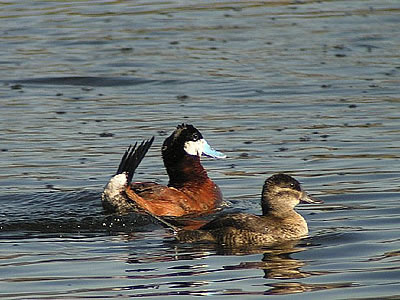
Just returned from a few days at Lee Vining/Mono Lake, which for you folks back east means just east of Yosemite. One of the highlights of the trip was a visit to a water treatment pond along highway 395, about 1.2 miles south of the June Lake Loop road. There we found a good gathering of Ruddy Ducks (Oxyura jamaicensis) sharing the bullrushes with American Coots and Yellow-headed Blackbirds. The male Ruddy Ducks were in a constant state of excitement, paddling about furiously with tails so erect and bent as almost to touch their heads! When he thought he had the attention of a female, he would frenetically bob/nod his head and bill at an astonishing rate, a performance that seemed to elicit little response from the female. The hens are a bit smaller, and seemed present in greater numbers. I read that they may lay eggs as late as August, so we guessed they were still choosing mates.
Here he's paddling furiously to overtake her, with tail raised to the limit. His neck is stretched and he's about ready to go into his head-bobbing seizure. The powder-blue bill and white cheek contrast with the brilliant electric chestnut body feathers in a manner that defies capture in a photo. We see these small "stiff-tailed" ducks all winter in their rather dull basic plumage, but in spring the males molt into this striking alternate plumage, deserting the Bay Area for fresh water breeding grounds.
2. American Coot(let ) - Fulica americana
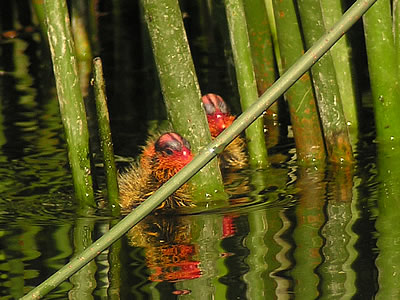
American Coot chicks are precocious, able to swim about shortly after birth. These two were foraging at the edges of the tules in the water treatment pond along 395, about 20 feet away from the Ruddy Ducks. Didn't see any adult Coots nearby. Not able to get much of a shot at 40' distance, but at least we can see the bright red-orange head. Chicks are pretty young, certainly less than 1 week and perhaps only 2-4 days. The red head makes you wonder. There must be some survival value, but you'd think cryptic feathers would be an advantage. Perhaps the red helps the parents keep track. Or perhaps Coot chicks are distasteful, and the bright color warns the predator in the same manner as the brightly colored poisonous frogs.
3. Violet-Green Swallow (Tachycineta thallassina)
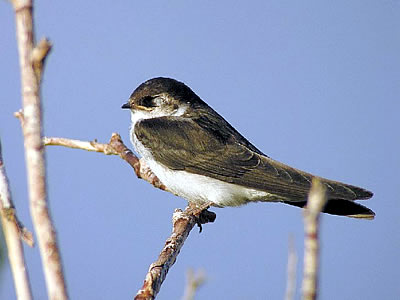
County Park at Mono Lake has a fair number of swallows, dominated by Violet-greens, and many of them were cooperative juveniles, sitting on bare branches and chirping for a parent to come and feed them (none did!).
Swallows are common world-wide (90 species), but only about 9 speices are seen in the US, 7 of which found in California. The Bahama Swallow (similar to the Tree Swallow) is sometimes seen in South Florida, and the Cave Swallow is a Mexican species that ranges toTexas and New Mexico, occasionally elsewhere. So that leaves us with 7 species, which include Purple Martin, Northern Rough-winged, Bank, Violet-green, Tree, Cliff and Barn Swallows. There are some locations in Marin (e.g. Las Gallinas ponds) where you can see 5 swallow species in one day. Well, some of my sharp-eyed birding friends can...
At County Park (Mono Lake again) there were mainly the beautiful Violet-greens. One thing I learned from reading is that a swallows flies with its mouth gaping open - very efficient when zooming through a cloud of insects. We saw many perched juveniles VG's, still sporting an yellow "gape", but none with the extravagant iridescence they will acquire with adult plumage (especially the male). Curiously most of them seemed to prefer to keep their eyes closed, like this one. Kids need their naps. Note the wide mouth, but short bill, typical of swallows.
4. Violet-Green Swallow, adult male
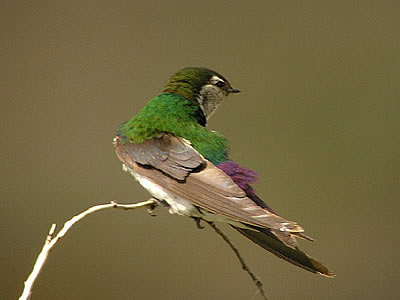
The Violet-green Swallow in flight shows light underparts, dark above. If the light is right you may some green on the back, but the best identifying feature is perhaps the extension of the white of the rump in a upward direction on the sides just behind the wings, rather more so than on the similar-appearing tree swallow. Some call this feature "saddle-bags". The tail is also shorter on the Violet-green, and those with good eyes may see that the white on the face extends to just above the eye, whereas on the Tree Swallow the eye is hidden in the dark feathers.
But when perched, and the light hits the feathers right, there are no questions, even if the face is hidden. The Tree Swallow shines with a striking metallic blue color on the head, and perhaps some color on the back, whereas the Violet-green just explodes with color. I'm still kicking myself that I couldn't get a sharper picture before this male flew, but I won't complain about the colors. I don't know if the 2 different green hues are real, or a function of the lighting. There is a lot of violet on the tail, but just a bit showing here.
5. Wilson's Phalarope (Phalaropus tricolor)
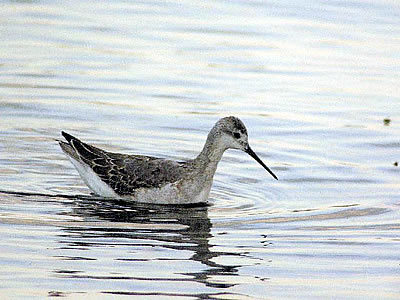
From Mono Lake's County Park again, where the phalaropes are gathering in large numbers for the long flights south. Wilson's Phalaropes will be going all the way to Argentina, so they really need to bulk up. The ranger said they may nearly double their weight feeding on the brine shrimp and brine flies. 90+% of the birds we saw were Wilson's and the rest were Red-necked. Both species had largely molted out of their colorful alternate (breeding) plumage. Wilson's are pretty distinctive, with the long needle-like bill and the absence of a dark ear patch behind the eye. They are also larger than the Red-necked. I believe this graceful bird is an adult, as the fringing of the coverts and tertials should be "buffy" on the juveniles, and here it appears gray. These are very special birds, and a joy to observe. Currently they are scattered on sheltered water around the Bay and on the coast.
Phalaropus = "Coot-footed", referring to the lobed toes, adapted for swimming. Tricolor = The three colors of the breeding female (gray, black, buff) - she has more striking plumage than the male.
Wilson = For Alexander Wilson (1766-1813), author of American Ornithology, and considered the father of American Ornithology. [See "Dictionary of Birds of the United States", 2003, by Holloway. A great little book that gives the derivation of all the names, common and scientific.]
6. Gray Plover (Pluvialis squatarola)
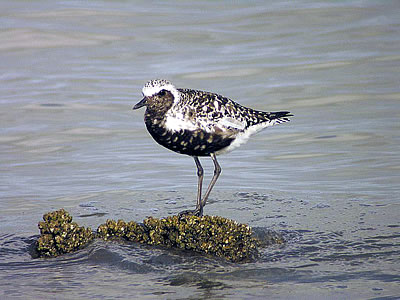
Pluvialis squatarola?? Say what? Well, "pluvialis" means "associated with rain" or "rainy", which explains little here. Worse yet, the French took the Latin pluvialis and gave these birds the name "pluvier", which became "plover" in English. So that leaves us with little to show for the derivation of either the Latin (genus) or the common name. "Squatrola" comes from the Venetian name for this bird, which adds even less clarity in terms of description. But in the U.S. we know it as the Black-bellied Plover, which helps a bit, but in the genus Pluvialis there are 4 large plovers, and they ALL HAVE BLACK BELLIES! Well, name frustrations aside, this large handsome plover is a dominant species along our coast, and we see it too briefly in this striking alternate (breeding) plumage.
I prefer the Brits' moniker of "Grey Plover", as most of the year it helps distinguish P. squatarola from its "golden-plover" cousins, namely the European Golden Plover (P. apricaria), American GP (P. dominica) and Pacific GP (P. fulva). The Black-bellied Plover has black axillaries, a somewhat bigger bill, and generally lacks yellow body spots or buffy head colors, or so I read in the guidebooks. During most of the year it is a rather plain gray on the back. This male was taken last week along the Hayward Regional Park shore, San Francisco Bay (near Frank's Dump) is anything but gray, but as you can see he is beginning to molt and will soon blend into the color of the bay.
7. Red-necked Phalarope juvenile (Phalaropus lobatus)
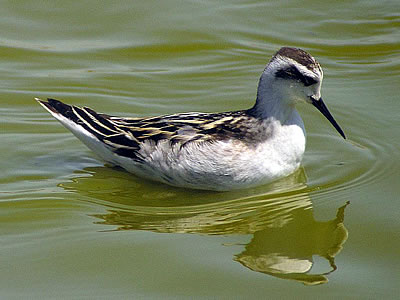
A wave of phalaropes is passing through the Bay Area as they head south on their fall migration. Molting starts even as they leave their breeding grounds, but apparently is quite variable, resulting in a varied spectrum of plumages to confound and please the viewer. If you haven't been out to see them, now is the time. Good numbers (Wilson's and Red-necked) were reported at Shollenberger Marsh in Petaluma on Saturday, Aug 12, but they are widely scattered and easily found all along the coast. We returned to the Hayward shore yesterday and watched about 40 phalaropes feeding in the shallow water of Frank's Dump (hey, I didn't name the place!). All were Red-necked. I believe this bright one is a juvenile, from what I see and read in Paulson's "Shorebirds". Note the dark crown, the bold buffy stripes on the back, and the nicely defined buffy white edges on the tertials (back towards the wing-tips/tail area). My second guess would be a male in pre-basic molt.
Digi-scoping phalaropes requires good equipment and three hands. The birds are in constant motion, as you can see from the bow wave. I increase the ISO to 100 to get a faster shutter speed (1/500) and back off on the camera's zoom to get a wider view and keep the bird in the frame. I try to "lead" the bird as I take photos, but most shots still show them swimming out of the frame, like here. Sometimes I only get the tail! Digital cameras have a bit of a "lag" before the photo is captured, and you have to figure that in. Also under-exposed by about .7 f stop to avoid burning out the white.
8. The Age of Pelicans
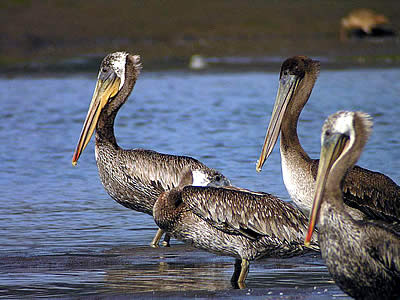
The Brown Pelican (Pelecanus occidentalis) is a common sight along the West Coast. They breed a bit further south, especially in Baja California, and then disperse to favored feeding areas both north and south. They are abundant in Marin County, and many hundreds can be seen on Bolinas Lagoon, where these youngsters were caught hanging out yesterday. Their numbers have recovered from the disastrous decline when DDT and other insecticides in the 1950-60's caused thinning of the eggshells.
The dark-capped one with the gray bill is likely only a few months old, therefore a "juvenile". The others have are showing signs of developing white on their heads and yellow on the bill, but are still "sub-adult". No white-headed adults in this grouping. Note too how the back feathers are "fringed" on these younger birds.
9. White Pelican (Pelicanus erythrorhyncus)
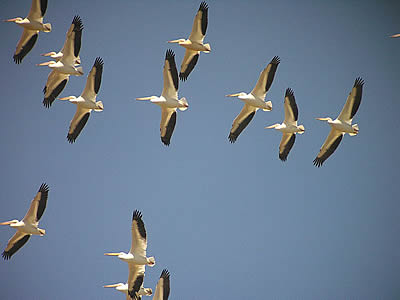
Shollenberger Marsh is usually a productive birding spot. Michael Stevenson and I were birding along the southern berm, out towards the southwest corner. I was intently focused on a Baird's Sandpiper, who was conveniently positioned near both a Western and Least Sandpiper. What luck! Then Michael said, "Look up", and we viewed one of those awesome sights that can take your breath away (see photo).
This group was part of a squadron of some fifty White Pelicans, circling lazily in a thermal and in no particular hurry to settle down. These birds are often seen at Las Gallinas Ponds, but they forage opportunistically all along the Marin wetlands, from Corte Madera to Petaluma, and probably out along Highway 37. Taken through a scope, which was not an easy task.
Order: Pelecaniformes (includes Cormorants, Anhinga and Boobies)
Family: Pelecanidae, the Pelicans (only the White and Brown in the US)
Genus: Pelecanus
Species: Pelecanus erythrorhyncus - American White Pelican.
As you might have guessed, Pelecanus means pelican (from the Greek), and "erythrorhyncus" means "red-snouted", referring to the orange bill (go figure). All in all one of the great creatures to grace our skies, with a wingspan that challenges the California Condor (9 feet!), and a length of 62", longer than the Trumpeter Swan. The White Peli weighs about 16-18 pounds, but specimens have reached up to 30 pounds, making his case for America's biggest bird! Note now it has evolved black tips for all the flight feathers, as in many larger birds. Melanin is said to add strength to the feathers.
10. Turkey Vulture - Supreme Static Soarer
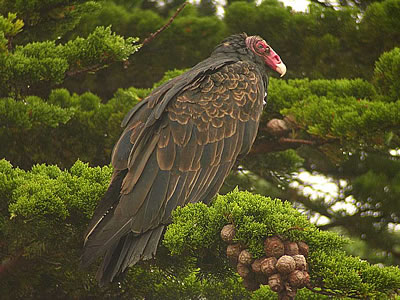
"Soaring" is flying with minimal flapping of the wings. "Static soaring" refers to soaring flight occurring in rising air, such as on thermals. And no birds are better at it than the vultures. "Dynamic soaring" refers to flight made possible by flying into a sustained wind, such as occurs at sea, and no birds can match the albatrosses. See the Birder's Handbook for a discussion of how the markedly different wing types allow efficient flight in these differing conditions. One interesting thing I learned is that the static soaring birds spread their "fingers" (primary feathers of the wing) to reduce drag and prevent stalling. (See the photo of the White Pelicans as an example). At any rate, the result in the case of the Turkey Vulture, Cathartes aura, is a bird capable of soaring endlessly in a thermal while expending minimal energy. The bird drops at about 2 feet per second, so it needs a thermal rising at least that fast to sustain flight. When Rich Stallcup's group gathered at Doran Beach 8/24 for what turned out to be a spectacular day of birding, we were treated to a group of Turkey Vultures roosting in Monterrey Cypress, waiting for the sun to create the thermals they need for soaring flight. Haven't been able to capture a decent image of this remarkable and useful scavenger before this one. The birds are really more brown than black, and the soft light allows us to see some feather detail. See below for some taxonomy.
Some older books grouped the Turkey Vulture with the raptors, in the order Falconiformes. The Old World Vultures (Eurasia, Africa) are indeed relatives of the raptors, and are properly within the Falconiformes, in the family Accipitridae, along with the Osprey, Kites, Harriers, Sea-eagles, etc. But anatomic differences and DNA evidence have led taxonomists to place the Turkey Vulture, along with the 6 other species of New World Vultures, in a quite different order, namely Ciconiiformes, along with the Herons, Ibises, Spoonbills and Storks. If you've seen a Wood Stork then the relationship begins to make some sense.
Order: Ciconiiformes
Family: Cathartidae (New World Vultures) - Includes the Condors (Andean & Calif), Yellow-Headed
V's, King, Black and Turkey V's.
Genus: Cathartes
Species: Cathartes aura. "Cathartes" means a purifier, or cleanser, and these guys certainly do
that in a major way with their scavenging. They eat mainly carrion, although they have been seen
taking small live prey such as ciconiform chicks.
TOWHEE.NET: Harry Fuller, 820 NW 19th Street, McMinnville, OR 97128
website@towhee.net